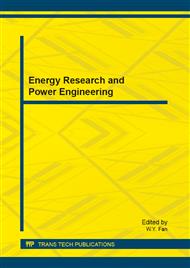[1]
Tang M, Stuart T, Selective buck-boost equalizer for series battery packs, IEEE Transactions on Aerospace and Electronic Systems, 2000, 36(1): 201~211.
DOI: 10.1109/7.826322
Google Scholar
[2]
Kuhn B T, Pitel G E, Krein P T, Electrical properties and equalization of lithium-ion cells in automotive applications, IEEE Vehicle Power and Propulsion Conference, 2005, 55~59.
DOI: 10.1109/vppc.2005.1554532
Google Scholar
[3]
Kong Zhi-Guo, Zhu Chun-Bo, Lu Ren-Gui etc, Comparison and Evaluation of Charge Equalization Technique for Series Connected Batteries, the Science Garden of Harbin Instistute of Technology,37th IEEE PESC'06, 2006, 3:1~6.
DOI: 10.1109/pesc.2006.1711751
Google Scholar
[4]
Jinchun Peng, Russ Eberhart, Yaobin Chen, Battery Pack State of Charge Estimator Design Using Computational Intelligence Approaches, IEEE, 2000, 173~177.
DOI: 10.1109/bcaa.2000.838400
Google Scholar
[5]
H. Sakamoto, K. Murata, E. Sakai, K. Nishijima, K. Harada, S. Taniguchi, K. Yamasaki and G. Ariyoshi, Balanced Charging of Series Connected Battery Cells, Telecommunication Energy Conference 1998, p.311~315.
DOI: 10.1109/intlec.1998.793517
Google Scholar
[6]
N.H. Kutkut, D.M. Divan, D.W. Novotny, H.L.N. Wiegman, Charge Equalization for series Connected Battery Strings, U.S. Patent Application, Oct. (1995).
DOI: 10.1109/ias.1994.377541
Google Scholar
[7]
W. Liye, W. Lifang, L. Chenglin and L. Jun, Research on battery balance system applied on HEV, in Proc. 2009 Vehicle Power and Propulsion Conference, 2009. VPPC '09. IEEE, pp.1788-1791.
DOI: 10.1109/vppc.2009.5289666
Google Scholar
[8]
M. Daowd, N. Omar, P. van den Bossche and J. Van Mierlo, Passive and active battery balancing comparison based on MATLAB simulation, in Proc. 2011 Vehicle Power and Propulsion Conference (VPPC), 2011 IEEE, pp.1-7.
DOI: 10.1109/vppc.2011.6043010
Google Scholar
[9]
C. Jian, N. Schofield and A. Emadi, Battery balancing methods: A comprehensive review, in Proc. 2008 Vehicle Power and Propulsion Conference, 2008. VPPC '08. IEEE, pp.1-6.
DOI: 10.1109/vppc.2008.4677669
Google Scholar
[10]
W. F. Bentley, Cell balancing considerations for lithium-ion battery systems, in Proc. 1997 Battery Conference on Applications and Advances, 1997, Twelfth Annual, pp.223-226.
DOI: 10.1109/bcaa.1997.574107
Google Scholar
[11]
Y. C. Zhang, C. Y. Wang and X. D. Tang, Cycling degradation of an automotive LiFePO(4) lithium-ion battery, JOURNAL OF POWER SOURCES, 2011, vol. 196, pp.1513-1520.
DOI: 10.1016/j.jpowsour.2010.08.070
Google Scholar
[12]
M. Einhorn, W. Roessler and J. Fleig, Improved Performance of Serially Connected Li-Ion Batteries With Active Cell Balancing in Electric Vehicles, Vehicular Technology, IEEE Transactions on Vehicular Technology, 2011, vol. 60, pp.2448-2457.
DOI: 10.1109/tvt.2011.2153886
Google Scholar
[13]
M. Einhorn, F. V. Conte, C. Kral and J. Fleig, A Method for Online Capacity Estimation of Lithium Ion Battery Cells Using the State of Charge and the Transferred Charge, Industry Applications, IEEE Transactions on Industry Applications, 2012, vol. 48, pp.736-741.
DOI: 10.1109/tia.2011.2180689
Google Scholar
[14]
S. Lukic, Charging ahead, Industrial Electronics Magazine, IEEE Industrial Electronics Magazine, 2008, vol. 2, pp.22-31.
DOI: 10.1109/mie.2008.930361
Google Scholar


